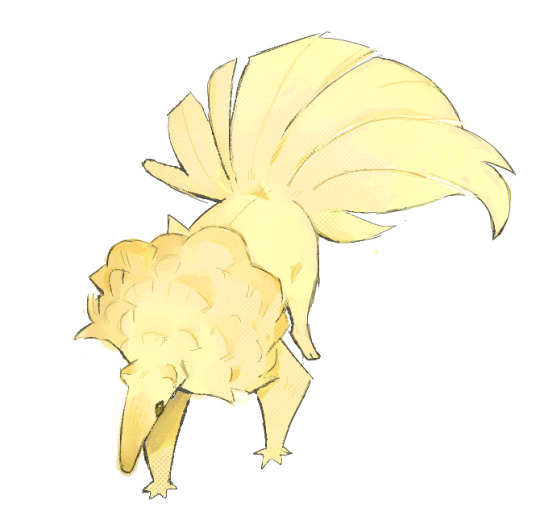#albino anteater
Text

Alvinho, the albino giant anteater (he’s wearing a GPS collar).
13K notes
·
View notes
Text

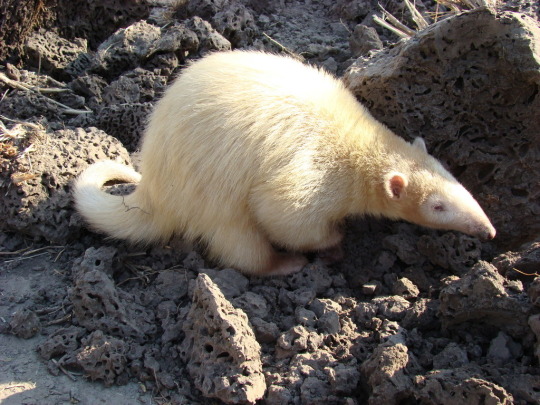
Melanistic and Albino Southern tamandua (Tamandua tetradactyla) [x] [x]
#melanistic#melanism#albino#albinism#southern tamandua#lesser anteater#tamandua#anteater#Tamandua tetradactyla#mammal#color mutation
7K notes
·
View notes
Text
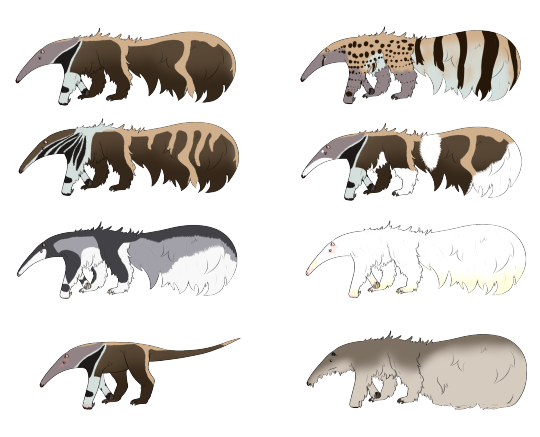
Anteaters if anteaters were domesticated and had morphs.
Standard, Genet
Overlined, Piebald
Ashen, Albino
Naked, Angora
#my art#bloom#speculative zoology#speculative biology#anteater#anteaters#weird animal#art#digital art
121 notes
·
View notes
Text
Never actually listed everyone out before so here’s the list!
Maka - Desert Hare/Red Fox
Soul - Arapawa Ram (with distant unknown wolf lineage)
Black☆Star - Indian Peacock
Tsubaki - Black Leopard
Kid - Swamp Deer
Liz - Coyote
Patty - Coyote(maybe mixed with terrier breed? Coywolf?)
Crona - Lavender King Snake
Ragnarok - Shield nose cobra
Medusa -Rhinoceros viper
Marie - Cheetah
Stein - Gray Wolf (reptile lineage)
Spirit - Red Fox
Death - Irish Elk
Justin - Alpine Goat
Giriko - Golden Jackal
Eruca - Glass Frog
Mifune - Arctic Fox
Sid - Belgian Draft Horse
Naigus - Gemsbok
Asuza - Border Collie
Angela - Carpet Chameleon
Hero - Lion
Joe - Golden Mole
Arachne - Spider Tailed Horn Viper
Asura - Fallow Deer
White Star - Albino Peacock
Kilik - Asatic Golden Cat
(His weapons) - Flat Headed Cats
Kim - Galapagos pink land iguana
Jackie - Greater rhea
Ox - Yorkshire pig
Harvar - Giant anteater
Vajra-Nilgiri marten
#beastars au#beastars au List#soul eater beastars#soul eater#soul eater au#I’m not tagging everybody
15 notes
·
View notes
Text
So here's like some of the ideas for like the TPOT monster object au thing... Like the animals they would be and whatnot...
Marker: Salamander
Fanny: Cat
Tree: Deer
Lightning: Canary
Pie: Raccoon
Remote: Armadillo
Pillow: Sheep
Bottle: Glass frog
Pen: Bluejay
Black Hole: Literally just a void snake lol
Snowball: Polar bear
Bell: Copper colored hummingbird
Foldy: Chameleon ( teal colored )
Grassy: Leaf bug
Basketball: Tiger
Robot flower: Galah
Eggy: Lavender albino pall python ( long name... )
Tennis ball: Green ringtail possum
Golfball: Chinchilla
Eraser: Galapagos pink land iguana ( give me better suggestions pls T^T )
Pin: Red lory
Coiny: Meerkat
Needle: Anteater
Doughnut: Fennec fox
Barf bag: Skunk
Saw: Prairie lizard
Gaty: Possum
Yellow face: Banana slug
If you have any better suggestions, pls let me know!
I know this is not all of the characters but this is all the ones i could think of at the moment lol
8 notes
·
View notes
Text
Alvin 🥹🥹🥹
12 notes
·
View notes
Note
your full name is alvinho the albino giant anteater?
Alvinho the Albino GIant Anteater Vincente

5 notes
·
View notes
Note
Assumption: Shaw wouldn't be a pet owning kind of guy but if he ever did it would be something that he treated as a living display that he could use to boost his image. A huge iguana enclosure in the middle of his office? A teigu enclosure? How about a caiman pool? Maybe not snakes I can't see him with big snakes but I can see him with geckos or chameleons . Maybe a melanistic macaw. If it has to have fur it's gotta be a Ferret colony nothing says nefarious like a Ferret randomly stealing your pen and running off after you sign over your life to this doucheyatch.
If we go to exotics which I don't support but there are definitely ones I can see but tbh I feel like he'd think they were an inconvenience and he doesn't have time for that. A pangolin would be good. Or an ant eater. Honestly anteaters are terrifying.
ANT EATERS ARE SO FUCKIN TERRIFYING
And yeah, I don't see Shaw as a pet type of guy for their own sake, but a "status symbol" type deal. I personally write him keeping expensive black draft horses but I also feel like he's had like, exotic big cats here and again (tho I feel those are more a Shinobi thing, Shin has totally collected shit like albino tiger cubs and stuff)
"nothing says nefarious like a Ferret randomly stealing your pen and running off after you sign over your life to this doucheyatch."
LOOOOOL
@shattered-catalyst
#shattered catalyst#abundance of white animals sighted all over Blackstone#but they're all Snowbird harassing him
6 notes
·
View notes
Text
World's only known albino giant anteater appears to be thriving in the wild, photos show
The white anteater, known as Alvin, was first spotted late last year clinging to his mother's back.
from Livescience https://www.livescience.com/animals/land-mammals/worlds-only-known-albino-giant-anteater-appears-to-be-thriving-in-the-wild-photos-show
via IFTTT
0 notes
Text

Screenshot taken using my mod, Albino Giant Anteaters
#planet zoo#giant anteaters#anteaters#albino anteater#anteater#south america dlc#animals#planet zoo mods#planet zoo screenshot
15 notes
·
View notes
Photo
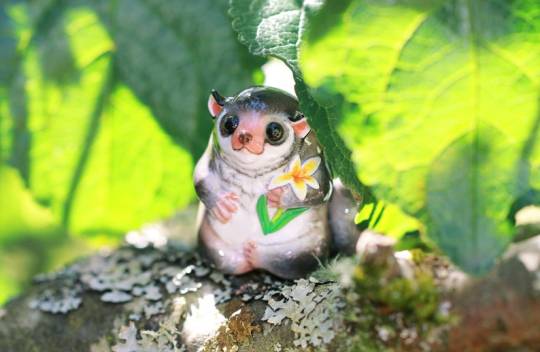
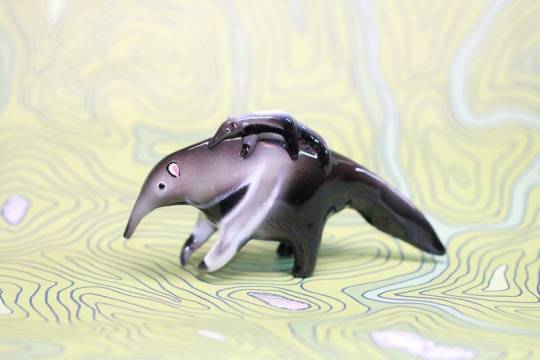


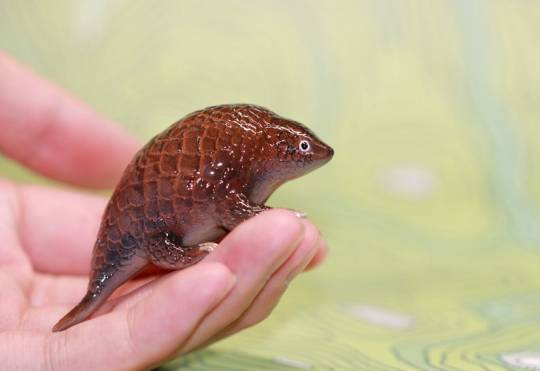
Polymer Clay Figurines // FoxLuuCreations
Baby Drawf Lemur
Anteaters
Abbey the Ghost Albino Bat
Beaver
Pangolin
98 notes
·
View notes
Text
Kelenken guillermoi
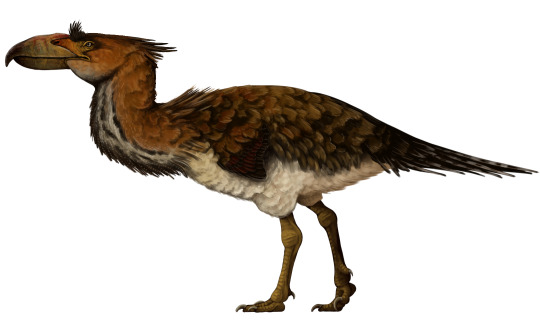
By Scott Reid
Etymology: For Kélenken, the Bird of Prey Spirit of the Tehuelche Tribe
First Described By: Bertelli et al., 2007
Classification: Dinosauromorpha, Dinosauriformes, Dracohors, Dinosauria, Saurischia, Eusaurischia, Theropoda, Neotheropoda, Averostra, Tetanurae, Orionides, Avetheropoda, Coelurosauria, Tyrannoraptora, Maniraptoromorpha, Maniraptoriformes, Maniraptora, Pennaraptora, Paraves, Eumaniraptora, Averaptora, Avialae, Euavialae, Avebrevicauda, Pygostaylia, Ornithothoraces, Euornithes, Ornithuromorpha, Ornithurae, Neornithes, Neognathae, Neoaves, Inopinaves, Telluraves, Australaves, Cariamiformes, Phorusrhacoidea, Phorusrhacidae, Phorusrhacinae
Status: Extinct
Time and Place: Between 15.5 and 13.8 million years ago, in the Langhian age of the Miocene of the Neogene

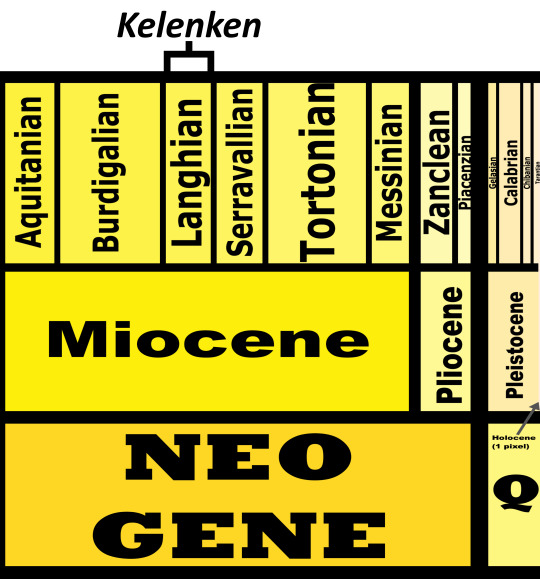
Kelenken is known from the Collón Curá Formation of Rio Negro Province, Argentina
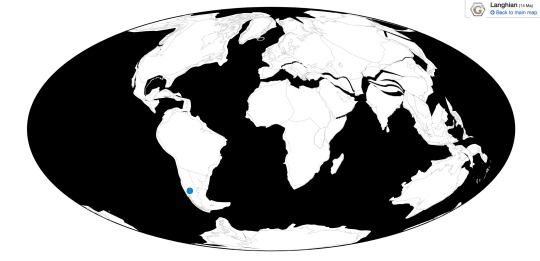
Physical Description: Kelenken was a Terror Bird, a type of large flightless terrestrial dinosaur from the late Cenozoic era, mostly in South America though a few reached North America when the continents collided. These were some of the top predators of their environments, built for chasing down food over long distances and then using their monstrous beaks to tear into flesh. Kelenken was one of the biggest members of the group, about two meters tall, and it had one of the largest known skulls of any bird, with fused bones to give it significant strength in its head and strong bire force. Its limbs were very robust, probably allowing for powerful movements of the legs. It had very small wings, as other Terror Birds did, and as such they probably weren’t used very much (think of the arms of Carnotaurus but the bird version). It had a long, winding neck, and its head was mostly beak. The beak was hooked at one end. It had a short tail, though we don’t have any feather impressions to know if it had any sort of feather decoration at the end of it. It would have had a huge bite force, and it possibly was a faster runner than other Terror Birds.
Diet: Kelenken primarily fed on large animals, especially faster moving ones such as hoofed mammals
Behavior: Kelenken probably spent most of its time chasing down its prey, though it’s uncertain how. It’s possible that it would chase down prey, catch it, and shatter its bones with its beak by repeatedly pecking at it (if… pecking is an accurate word to use with such a huge beak doing the pecking). It’s also possible that it would chase down smaller prey, pick it up, and shake it vigorously to break the prey’s back. It also possibly scavenged off of prey. Honestly, it seems likely that Kelenken would utilize all these strategies, and those not even come up with, to get any prey it could in an opportunistic fashion.

By Michael B. H.
Kelenken was a fairly fast animal, and probably able to run for longer distances. As its environment was transitioning to an open grassland rather than a forest, this ability to run moreso than its earlier relatives was probably a direct adaptation for that open habitat. As such, Kelenken would have been extremely alert and on the lookout, both for food and for potential dangers, as it was tall enough to poke out above the grass and be visible to anything looking for it. Kelenken could fight with others of its species and against other animals both with its beak and with its feet, as it had very robust legs that would have been good for kicking, possibly very rapid and sharp kicks.
As only a few specimens of Kelenken are known, it’s difficult to determine its social behavior, especially since its closest living relatives are the Seriemas - a much smaller sort of dinosaur. Still, it’s possible to at least glean some behavioral patterns from seriemas. It’s possible that, like living seriemas, Kelenken only spent its time in pairs and small groups, which may have worked together cooperatively to take down larger mammalian sources of prey. It’s also possible that it may have been territorial over its nests, with breeding pairs avoiding other Kelenken and fighting with those they come across. This is all speculative, but would make sense given the environment and size of the animals. Kelenken, being a bird, almost decidedly took care of its young, though we cannot know if both parents took care of the young as in modern Seriemas, or if only one parent did the job at a time as in modern flightless birds. More fossils might be able to clear up this picture, though of course, it’s possible we’ll never know.
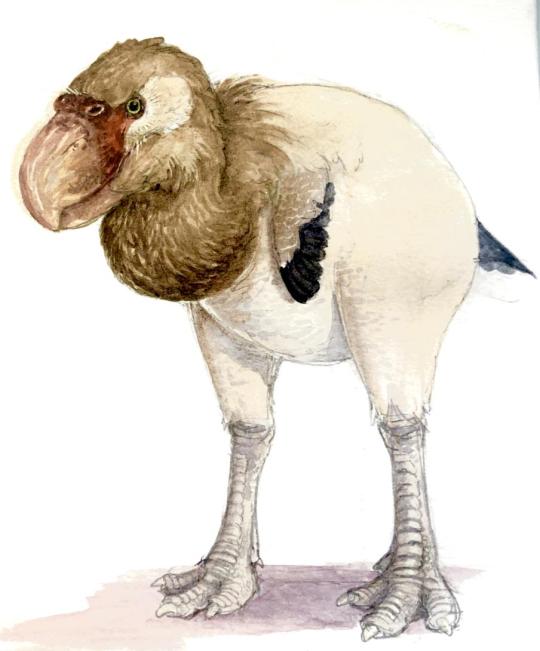
By Ripley Cook
Ecosystem: Kelenken lived in the part of the Miocene that was the hottest, called the Middle Miocene Climatic Optimum. This was immediately followed by drastic cooling. Thus, Kelenken lived in a uniquely warm period of the time in which Terror Birds dwelled. The formation was surrounded by extensive rivers and lakes, as basins formed in South America due to tectonic plates separating. This environment was a growing grassland, with the pampa overtaking the old deciduous forest that had once been there.
Kelenken is the only dinosaur known from the formation, but there were many different types of mammals present. There were the heavy-bodied hoofed mammals Protypotherium, Epipatriarchus, and Interatherium; the smaller hoofed mammals Hegetotherium and Pachyrukhos; the weird fast hoofed mammal related to Macrauchenia, Theosodon; armadillo relatives such as Proeutataus, Paraeucinepeltus, Peltephilus, Prozaedyus, and Stenotatus; the anteater relative Neotamandua; the rodents Galileomys, Guiomys, Maruchito, Microcardiodon, Neosteiromys, Protacaremys, Acarechimys, Alloiomys, Megastus, Neoreomys, Prolagostomus, and Stichomys; the new-world monkey Proteropithecia; the sabre-toothed marsupial Patagosmilus; and the extinct shrew opossum relative Abderites. There were also reptiles such as boa relatives like Waincophis, lizards, and turtles like Chelonoidis. There was also the horned frog Wawelia.
Kelenken probably would have hunted a variety of these things, especially the hoofed mammals, though some would have been too big for it to eat. It definitely would have been in direct competition with Patagosmilus, which probably would have specialized on different prey than Kelenken.
Other: Kelenken is most closely related to phorusrhacids such as Phorusrhacos and Titanis, two of the other more famous genera in this group.
~ By Meig Dickson
Sources under the Cut
Abello, María Alejandra, and David Rubilar Rogers. 2012. Revisión del género Abderites Ameghino, 1887 (Marsupialia, Paucituberculata). Ameghiniana 49. 164–184. Accessed 2019-02-15.
Albino, A.M. 1996. Snakes from the Miocene of Patagonia (Argentina) Part I: The Booidea. Neues Jahrbuch für Geologie und Paläontologie, Abhandlungen 199. 417–434. Accessed 2019-02-27.
Angolin, F. L., P. Chafrat. 2015. New fossil bird remains from the Chinchinales Formation (Early Miocene) of Northern Patagonia, Argentina. Annales de Paleontologie 101: 87 - 94.
Baez, A. M., S. Peri. 1990. Revision de Wawelia gerholdi, un anuro del Mioceno de Patagonia. Ameghiniana 27(3-4):379-386
Bertelli, S., L. M. Chiappe, C. Tambussi. 2007. A new phorusrhacid (Aves: Cariamae) from the middle Miocene of Patagonia, Argentina. Journal of Vertebrate Paleontology 27(2): 409 - 419.
Bondesio, P.; J. Rabassa; R. Pascual; M.G. Vucetich, and G.J. Scillato Yané. 1980. La formación Collón-Curá de Pilcaniyeú Viejo y sus alrededores (Río Negro, República Argentina) su antiguedad y las condiciones ambientales según su distribución su litogenesis y sus vertebrados. Actas del Segundo Congreso Argentino de Paleontología y Bioestratigrafía y Primer Congreso Latinoamericano de Paleontología 3. 85–99.
De Broin, F., and M. De la Fuente. 1993. Les tortues fossiles d'Argentine: synthese (The fossil turtles of Argentina: synthesis). Annales de Paléontologie (Invertebrés-Vertebrés) 79. 169–232. Accessed 2019-02-27.
Forasiepi, A.M., and A.A. Carlini. 2010. A new thylacosmilid (Mammalia, Metatheria, Sparassodonta) from the Miocene of Patagonia, Argentina. Zootaxa 2552. 55–68. Accessed 2019-02-27.
Gonzaga, L. P., A. Bonan. 2017. Seriemas (Cariamidae). In: del Hoyo, J., Elliott, A., Sargatal, J., Christie, D.A. & de Juana, E. (eds.). Handbook of the Birds of the World Alive. Lynx Edicions, Barcelona.
González Ruiz, Laureano Raúl; Flavio Góis; Martín Ricardo Ciancio, and Gustavo Juan Scillato Yané. 2013. Los Peltephilidae (Mammalia, Xenarthra) de la Formación Collón Curá (Colloncurense, Mioceno Medio), Argentina. Revista Brasileira de Paleontologia 16. 319–330. Accessed 2019-02-27.
González Ruiz, Laureano Raúl; Alfredo Eduardo Zurita; Gustavo Juan Scillato Yané; Martín Zamorano, and Marcelo Fabián Tejedor. 2011. Un nuevo Glyptodontidae (Mammalia, Xenarthra, Cingulata) del Mioceno de Patagonia (Argentina) y comentarios acerca de la sistemática de los gliptodontes "friasenses". Revista Mexicana de Ciencias Geológicas 28. 566–579. Accessed 2019-02-27.
Kay, R.F.; D. Johnson, and J. Meldrum. 1998. A new Pitheciin Primate from the Middle Miocene. American Journal of Primatology 45. 317–336. Accessed 2019-02-27.
Kramarz, Alejandro; Alberto Garrido; Analía Forasiepi; Mariano Bond, and Claudia Tambussi. 2005. Estratigrafia y vertebrados (Aves y Mammalia) de la Formación Cerro Bandera, Mioceno Temprano de la Provincia del Neuquén, Argentina. Revista Geológica de Chile 32. 273–291. Accessed 2017-10-20.
McDonald, H.G.; S.F. Vizcaíno, and M.S. Bargo. 2008. Skeletal anatomy and the fossil history of the Vermilingua, 64–78. S. F. Vizcaíno, W. J. Loughry (eds.), The Biology of the Xenarthra. Accessed 2019-02-27.
Náñez, Carolina, and Norberto Malumián. 2019. Foraminíferos miocenos en la cuenca Neuquina, Argentina: implicancias estratigráficas y paleoambientales. Andean Geology 46. 183–210. Accessed 2019-02-27.
Oriozabala, C.; J. Sterli, and L. González Ruiz. 2018. Morphology of the mid-sized tortoises (Testudines: Testudinidae) from the Middle Miocene of Northwestern Chubut. Ameghiniana 55. 30–54. Accessed 2019-02-27.
Pardiñas, U.F.J. 1991. Primer registro de primates y otros vertebrados para la Formacion Collón Curá (Mioceno medio) del Neuquén, Argentina (First record of primates and other vertebrates from the Collón Curá Formation (middle Miocene) of Neuquén, Argentina). Ameghiniana 28. 197–199. Accessed 2019-02-27.
Pearson, Paul N., and Martin R. Palmer. 2000. Atmospheric carbon dioxide concentrations over the past 60 million years. Nature 406. 695–699. Accessed 2019-02-27.
Pérez, M.E., and M.G. Vucetich. 2011. A new Extinct Genus of Cavioidea (Rodentia, Hystricognathi) from the Miocene of Patagonia (Argentina) and the Evolution of Cavoid Mandibular Morphology. Journal of Mammalian Evolution 18. 163–183. Accessed 2019-02-27.
Pérez, M.E.. 2010. A new rodent (Cavioidea, Hystricognathi) from the middle Miocene of Patagonia, mandibular homologies, and the origin of the crown group Cavioidea sensu stricto. Journal of Vertebrate Paleontology 30. 1848–1859. Accessed 2019-02-27.
Rehr, D. 2007. Prehistoric Predators - Terror Bird. 5:40 - 11:40. National Geographic.
Silvestro, Daniele; Marcelo F. Tejedor; Martha L. Serrano Serrano; Oriane Loiseau; Victor Rossier; Jonathan Rolland; Alexander Zizka; Alexandre Antonelli, and Nicolas Salamin. 2017. Evolutionary history of New World monkeys revealed by molecular and fossil data. BioRxiv _. 1–32. Accessed 2017-09-24.
Tambussi, C. P. 2011. Palaeoenvironmental and faunal inferences based on the avian fossil record of Patagonia and Pampa: what works and what does not. Biological Journal of the Linnean Society 103: 458 - 474.
Vera Nardoni, Bárbara; Marcelo Reguero, and Laureano González Ruiz. 2017. The Interatheriinae notoungulates from the middle Miocene Collón Curá Formation in Argentina. Acta Palaeontologica Polonica 62. 845–863. Accessed 2019-02-27.
Vucetich, M.G., and A.G. Kramarz. 2003. New Miocene rodents from Patagonia (Argentina) and their bearing on the early radiation of the Octodontoids (Hystricognathi). Journal of Vertebrate Paleontology 23. 435–444. Accessed 2019-02-27.
Vucetich, M.G.; M.M. Mazzoni, and U.F.J. Pardiñas. 1993. Los roedores de la Formación Collón Curá (Mioceno Medio), y la ignimbrita Pilcaniyeú, Cañadón del Tordillo, Neuquén. Ameghiniana 30. 361–381. Accessed 2019-02-27.
#kelenken#kelenken guillermoi#terror bird#bird#dinosaur#birds#dinosaurs#birblr#palaeoblr#neogene#south america#carnivore#terrestrial tuesday#australavian#paleontology#prehistory#prehistoric life#factfile#biology#a dinosaur a day#a-dinosaur-a-day#dinosaur of the day#dinosaur-of-the-day#science#nature
311 notes
·
View notes
Text
Animal Planet's Jeff Corwin Headlined The 10th Annual Bridgeland Nature Fest 2017
Animal Planet’s Jeff Corwin Headlined The 10th Annual Bridgeland Nature Fest 2017
Photo: (Above: Jeff Corwin holding an Echidna) The crowds at the Bridgeland Nature Fest were all super excited to see this man!! Jeff Corwin of The Animal Planet. Photo: Jeff Corwin of The Animal Planet (Nice guy in person too!) – He stayed for photo’s and autographs for the crowds. Mr. Corwin certainly brought out the crowds and after watching his performance I understand why! He did a…
View On WordPress
#3-Banded Armadillo#Aardvark#Albino Burmese Python#Animal Planet#Animal Planet Jeff Corwin#Ant Eater#Anteater#Black and White Ruffed Lemur#Bridgeland Nature Fest#Burmese Python#Clay Hartle#Courtney Coritna Pineda Wild Things Zoofari#Echidna#Elisa Hartle#Gwen Scott TGR Exotics Wildlife Park#Jeff Corwin#Kangaroo#Lemur#Porcupine#Tamandua#Troy Scott TGR Exotics Wildlife Park
0 notes
Text
Click-by-Click commentary
Eft to Newt
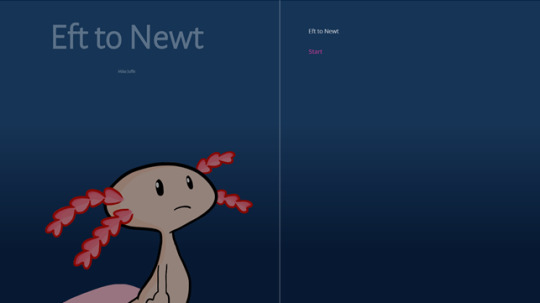
La schermata iniziale è, per quanto semplice nella possibilità di scelte (Indica infatti soltanto il titolo del gioco, che rimarrà comunque sempre visibile sulla sinistra assieme al nome dell’autore, ed il tasto start), reso particolarmente simpatico dalla presenza dell’axolotl che interpreteremo nel corso del nostro gameplay.
You wake to the sound of your phone going off. Same as always.
Slowly you climb out of bed. Your head is pounding, but you can't remember
what you were doing last night. You put your hand
to your forehead, surprised at how clammy it is, and head to the bathroom
L’inizio del gioco ci presenta una situazione perfettamente normale (“same as always”), per quanto siano presenti delle dissonanze con la routine che ci lasciano un po’ perplessi, e si accenna ad un possibile hang-over.
Se si decide di proseguire cliccando sul telefono, il gioco ci rivela la nostra suoneria (“A Horse with no Name”), che verrà comunque menzionata più avanti.
Scegliamo di dirigerci verso il bagno.
>>Bathroom
The bathroom is pitch dark. You blindly grope around looking for the
faucet, lights or whatever else you can find to establish your bearings
Segue una descrizione di come ci muoviamo per il bagno scarsamente illuminato, tastando in giro alla ricerca di interruttori della luce.
>>Lights
You find the lightswitch and flip it. Finally you can see the bathroom
around you. Your eyes are drawn to the mirror.
>>Mirror
Mirror costituisce qui una scelta obbligata, che dà luogo ad una descrizione del nostro nuovo aspetto:
The face you see in front of you is a long, flat oval. Two beady eyes
stare back at you, and a tiny mouth opens and closes.
There is no nose on this pale pink face, but on either side of the head
are a pair of bright red, feathery gills.
It is the face of an axolotl salamander, and through the sleep and
possible hang-over addled brain of yours, you slowly awaken to the idea
that this is your own face.
You need a few seconds to process if this is normal or not.
In seguito a quella che è la normalissima descrizione dell’aspetto di un axolotl, il gioco ci pone davanti alla prima scelta davvero importante del gioco, che segnerà uno svolgersi degli eventi completamente differente: In caso decideremo di scegliere “normal”, infatti, non ci mostreremo affatto stupiti di essere un axolotl, ed anzi, continueremo tranquillamente con la nostra vita.
In caso contrario, invece, il risultato sarà il seguente:
>>Not
The beady eyes in the mirror bulge slightly as you struggle to make sense of what you are seeing.
How does a normal human suddenly transform into an albino salamander
overnight? You think back to your earliest memory from the previous night
in hopes of some clue.
Back in the bedroom you can hear your phone switch from "A Horse With No Name" to "HangTough".
Someone is trying to call you.
Scandalizzati dal nostro riflesso, possiamo decidere o di ripensare agli svolgimenti della notte precedente (o almeno, quanto siamo in grado di ricordare di essa), o di andare alla ricerca dell’insistente cellulare, che, come ci era stato fatto notare prima, sta suonando da qualche parte in camera nostra.
Decidendo che non sia meglio perdere tempo, ispeziono il cellulare
>>Call you
You dash back into the bedroom as fast as you can, tearing through the
piles of dirty clothes and junk on the floor.
"Everybody's always worrying 'bout who's on toooop..."
They're going to hang up soon, you know it.
"Thank god you answered! I was worried you wouldn't be able to hold the
phone. I can barely manage myself! Something horrible has happened!"
You recognize the voice as being that of your sister.
"I woke up and Aaron was gone, in his place on the bed was a sea gull!
I freaked and tried to smack it away, but when I raised my hand it was this
huge... foot... thing was there and I smashed the bed in two!"
She begins crying.
"I'm some kind of elephant! I had to dial your number with my nose! Aaron panicked and flew into the window and now I think he's unconsious!
This has been happening all over the city!"
Facciamo quindi la conoscenza di nostra sorella, che a quanto pare si è svegliata nel corpo di una specie di elefante; veniamo quindi a sapere che anche Aaron (Probabilmente il suo ragazzo, ora una pulcinella di mare) è diventato un animale, e che lo stesso incidente si è verificato in tutta quanta la città.
Decidiamo quindi di accendere la TV, in quanto scelta obbligata.
You turn on the news and see that she is correct.
You turn on the TV to see the usual local anchor person replaced by a very distressed looking walrus.
He flops around on his desk with a combination of dehydration and
confusion.
"Wadies anwd gentwelmen. In awl my yeaws ov wepa-
wepoa-
wepawowa-
dowing news fings... I have neva in my wife seen somefing wike vis."
"Awl ova the countwy, weguwar human beings have tuwned into animaws."
You turn off the tv and go to the window.
Dopo che un tricheco che doveva un tempo essere un giornalista ci conferma ciò che nostra sorella ci aveva appena detto, ci affrettiamo verso la finestra, e cliccando sulla parola abbiamo accesso ad una descrizione di ciò che sta succedendo nel mondo esterno: Il caos più totale
Outside you see complete bedlam.
Cars have crashed as their drivers suddenly lost opposable thumbs. Exotic
hoofed mammals and birds struggle to get out of the way.
A terrified looking lion clutches its head in its pawsand rocks back and forth
while an anteater desperately tries to pull a lobster from
underneath a collapsed lamp-post.
Whatever has happened to you seems to have effected the whole world.
You can head outside to help the other transformed people if you want,
but you also still have your sister on the line...
Qua il gioco presenta alcuni personaggi (Un Leone terrorizzato, ad esempio) con cui sarà possibile interagire in caso decidessimo di uscire ad aiutare le persone sulla strada.
La scelta di uscire o rimanere a telefono con tua sorella sarà, come la precedente riguardo al nostro aspetto, determinante per il finale che vorremo ottenere.
Trovando poco probabile che un axolotl sia in grado di offrire aiuto a mammiferi grandi il triplo di lui, scelgo piuttosto di rimanere a telefono con mia sorella.
Mentre giocavo mi ha fatto sorridere come il protagonista, pur un poco turbato all’inizio, non abbia poi battuto ciglio alla propria situazione, non mostrandosi in alcuno stato di isteria ma anzi, quasi tranquillo nelle sue nuove spoglie di animale acquatico.
>>Still have your sister on the line
"Are you still there?" your sister is still freaked out, "I just checked Yahoo News! This has happened everywhere in the world!
Every person they can find has been transformed into an animal!
I need to get Aaron to a doctor. Please, stay safe!"
She hangs up and you think about what you've just heard. Everyone in the
entire world... in an instant humanity is gone.
But everyone still seems to have retained their intelligence, despite the
transformation. What could have done this...
There is a sudden knock at the door. You open it and see a beautiful,
definitely human, woman standing in the doorway.
She looks down on you in obvious disappointment.
"Rats, you too. Oh well, maybe the next apartment. I couldn't have done
it to EVERYONE."
She is starting to leave. You could try to talk to her and figure out
what she knows about this.Or you could head outside to help the other
transformed people.
Dopo aver salutato nostra sorella, che ci ha appena comunicato che la situazione è uguale in tutto il mondo, riflettiamo su cosa abbia mai potuto provocare una cosa simile, ma i nostri pensieri vengono interrotti da un bussare alla porta.
Dopo aver aperto, ci troviamo di fronte ad una bellissima donna, che sembra, con le sue parole, suggerire di saperne più di noi sull’origine della trasformazione (o addirittura ad esserne la responsabile diretta.)
Abbiamo ancora la possibilità di uscire ad aiutare le persone, ma, incuriosita dal nuovo personaggio sulla scena, preferisco scegliere di parlarle (entrambe le scelte qui costituiscono un’azione, in quanto cambiano lo svolgimento della trama).
>>Talk to her
"Hmm? Oh fine. Yeah, I did this. My name is Circe. Maybe you've heard of me?"
I have! Holy crap, I thought you were mythological
No, I don't keep up to date on crazy jerks who turn everyone into animal, sorry
Ammettendo facilmente (e con la più totale noncuranza) di essere l’autrice di quella che è una vera e propria fattura, si rivela essere Circe, la strega che trasformò i compagni di Ulisse in maiali.
In realtà entrambe le scelte qua dovrebbero portare più o meno agli stessi risultati, visto e considerato che Circe sembrerà particolarmente loquace e disposta a rispondere alle nostre domande.
Non volendo comunque mancare di rispetto ad una sorta di divinità (e temendo alla mia prima run una bad-ending in cui sarei stata trasformata in maiale), preferisco mostrarmi stupita e confessarle che la ritenevo un essere mitologico.
>>I have! Holy crap, I thought you were mythological
"Yes, most people do. I've tried to keep a low profile since the good old days in Greece. However, I was getting impatient with my search so I
decided to speed things up with this spell"
>>What spell?
La scelta è qui obbligata, e serve soltanto a mandare avanti la narrazione ed a spiegare le motivazioni di Circe. Non avendo provato ogni singola ending nel caso in cui si decida di uscire ad aiutare gli altri animali non posso esserne sicura, ma penso che questa route sia l’unica (fra quelle disponibili qualora non si consideri normale la nostra condizione di axolotl) a rivelare chi abbia trasformato gli esseri umani in animali.
"I've been looking for an appropriate romantic partner for some time. I'm not
picky, I just want to meet someone I can spend eternity with who
isn't deficient. Sadly, the same thing keeps happening. I meet a man or
woman who seems decent, we go out for awhile, but then they do or say
something to reveal just how unworthy they really are.
So I transform them into a beast and move on. What else can I do?
I'm a busy witch.
This world is full of terrible, petty, small-minded people and I was getting tired of disappointment.
That was when I realized my problem was I was searching too slowly.
So I cast this enchantment over the world. I specified that anyone I
couldn't love would be transformed into a beast. That way the work would
be done for me! I'd just travel around until I found the people
who hadn't been transformed, and know that I could date any one of them!
...But no one seems to have remained human...
Do you have any idea how demoralizing that is? To know that there is no
one in the world worthy of you? To be told through infallible,
magical means that there is no one you could love?
You selfish monsters!
Maybe the problem isn't everyone else
You're still human
Dopo che la donna si lancia in un lungo monologo sul perché abbia fatto ciò che ha fatto (e fondamentalmente rivelandoci che prova ancora non poco rancore verso Ulisse), assistiamo ad una demitizzazione della figura di Circe, che qui appare principalmente come una ragazza (donna?) frustrata e, come per altro è possibile chiamarla fra le scelte, egoista.
Inoltre la strega appare fin troppo concentrata su se stessa, tanto che dobbiamo quasi interrompere la sua sequela di domande retoriche per poter esprimere la nostra opinione.
Decidendo di porre fine alle sue lamentele vittimiste, ma sempre cercando di non inimicarmela, le faccio notare la sua condizione di umanità.
>>You are still human
"So? What does THAT matter?"
Do you love yourself? You can't love others until you love yourself
Procedendo con questa scelta obbligata, spieghiamo a Circe una verità semplice ma importante:
>>Do you love yourself? You can't love others until you love yourself
"What are you talking about!?"
Circe looks down at you very cross.
"That is pop psychology bs! So, what, you're saying that my spell
transformed everyone on the planet into an animal because
I don't 'love myself enough?' I'm AWESOME! I'm an all powerful witch! I... I deserve someone who knows that!"
The spell specified only people you COULD love
If you're so awesome why is no one else human?
Venendo accusati di essere, in pratica, degli psicologi da quattro soldi (Ed effettivamente la frase che abbiamo appena pronunciato sembra essere stata presa da un qualche libro di auto-aiuto), Circe sostiene poi di amarsi già, e non poco, e che necessita soltanto di qualcuno che sia in grado di capire quanto sia speciale come persona ed apprezzarla.
Non volendola stuzzicare più del dovuto (anche se entrambe le scelte portano a risultati simili), mi concentro sulla semantica:
>>The spell specified only people you COULD love
"I...
Wait... you mean the spell only took into account people I could love
right now, not people I could love in the future?"
>>Exactly! You cast the spell at a time when you aren't ready for a
relationship, so no one remained human!
"... That is possible. Magic can be tricky with wording like that...
If you are correct, then that would mean the enchantment will change.
People I could love will transform back to human when I am ready.
The spell could still be a success!"
That selfish thinking is the problem! You need to undo the spell and work
on yourself!
So if I help you learn to love yourself and get ready for a relationship,
everyone will turn back to normal?
Circa mi dà ragione sulla semantica e su come questa possa influire negativamente su un incantesimo, ma sembra determinata nel perseverare sulla sua posizione nonostante le nostre proteste. Considerando che da sola non ce la può fare e volendo ritornare umana il prima possibile, le offro il mio aiuto, mantenendo sempre il tono cordiale che ormai caratterizza questa mia partita, cercando di dissuaderla come possibile:
>>So if i help you learn to love yourself and get ready for
a relationship, everyone will turn back to normal?
"How can YOU help?"
I'm a licensed therapist
"Are you really?"
Yes I am
No, but I'm not going to let her know that!
Questa è l’ultima scelta della route, che ci porta infatti all’epilogo. In realtà, entrambe le scelte consentiranno all’umanità di riprendere le proprie fattezze, ma, a seconda se decideremo di mentire alla strega o meno, quella che cambierà sarà la nostra fine: Infatti, qualora non avessimo affatto una laurea in psicologia, Circe non solo lo scoprirebbe, ma rimarremmo anche bloccati in forma di axolotl a leggere pdf sulla psicologia e a chiederci dove abbiamo sbagliato.
Volendo a questo punto ritornare umana, decido di aver dedicato la mia vita alla psicologia.
>>Yes I am
You meet with Circe twice a week and begin discussing her past and her
feelings about relationships. You help her unpack the anger
from her relationship with Odysseus, her doomed tryst with Hermes,
her brief affair with the artist Arachne (and how she managed to pin the poor girl's transformation on Athena).
Over time, you help Circe find the confidence to care for herself.
As you do, more and more people begin to transform back to human.
The day soon comes when everyone is returned to their original form.
Ironically, now that she feels healthier and capable of loving and being loved, Circe has decided to instead take a break from relationships.
With her newfound confidence comes the realization that she doesn't
need to force a relationship or define herself by others. Now content to let relationships develop naturally, Circe returns to her
witchcraft business in Greece.
The general public never learns the truth about what caused the
transformations, or who helped save them. Eventually it is explained
away as a strange, world-wide halucination. Perhaps brought about by an anarchist cell or a mutated neurovirus.
But you know the truth.
Congratulations! This is ending numero siete.
Play again to find them all!
Il finale indica come questa sia soltanto una delle possibili ending (davvero tante, anche solo a partire dalla nostra inusuale condizione di axolotl), e forse una delle migliori in quanto riporta tutto alla normalità. Ho trovato il gioco estremamente simpatico e divertente (Le frasi di Circe, che allude per altro alle passate relazioni con Odisseo, Ermes e, sorpresa, con Arachne), e la mia passione per la mitologia mi ha portata ad apprezzare particolarmente questa ending.
Pur avendo provato altre routes, principalmente incuriosita da come si sarebbe svolta la storia se avessi confermato il mio essere nata axolotl, questa rimane infatti la mia preferita e quella, a mio avviso, più soddisfacente.
0 notes
Photo
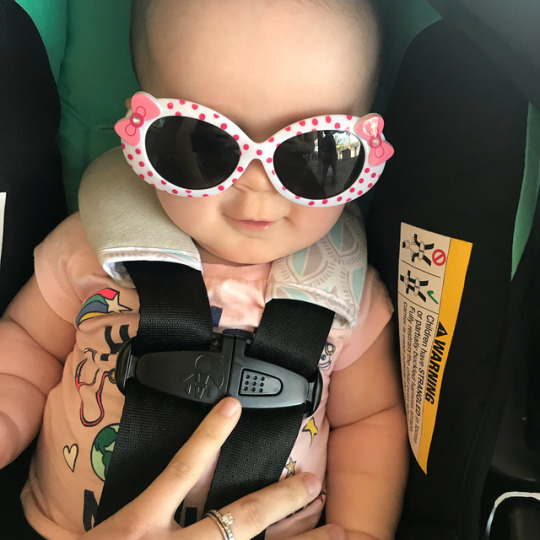
We had the best family day at the zoo! Only my kid would growl at the anteater and albino alligator and talk to a puma and yell at it when it didn’t talk back! #familyfunday #louisvillezoo #bestdayever
0 notes
